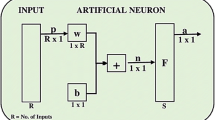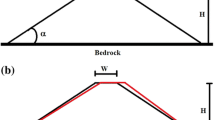Abstract
Slope stability analysis is one of the most important problems in geotechnical engineering. The development in slope stability analysis has followed the development in computational geotechnical engineering. This paper discusses the application of different recently developed artificial neural network models to slope stability analysis based on the actual slope failure database available in the literature. Different ANN models are developed to classify the slope as stable or unstable (failed) and to predict the factor of safety. The developed ANN model is found to be efficient compared with other methods like support vector machine and genetic programming available in literature. Prediction models are presented based on the developed ANN model parameters. Different sensitivity analyses are made to identify the important input parameters.





Similar content being viewed by others
References
Amari S, Murata N, Muller KR, Finke M, Yang HH (1997) Asymptotic statistical theory of overtraining and cross-validation. IEEE Trans Neural Netw 8(5):985–996
Bartlett PL (1998) The sample complexity of pattern classification with neural networks: the size of the weights is more important than the size of the network. IEEE Trans Inf Theory 44(2):525–536
Basheer IA (2001) Empirical modeling of the compaction curve of cohesive soil. Can Geotech J 38(1):29–45
Das SK (2005) Applications of genetic algorithm and artificial neural network to some geotechnical engineering problems. Ph.D. Thesis, Indian Institute of Technology Kanpur, Kanpur, India
Das SK, Basudhar PK (2006) Undrained lateral load capacity of piles in clay using artificial neural network. Comput Geotech 33(8):454–459
Das SK, Basudhar PK (2008) Prediction of residual friction angle of clays using artifical neural network. Eng Geol 100(3–4):142–145
Das SK, Samui P, Sabat AK, Sitharam TG (2009) Prediction of swelling pressure of soil using artificial intelligence techniques. Environ Earth Sci 61(2):393–403
Demuth H, Beale M (2000) Neural network toolbox. The MathWorks Inc, USA
Garson GD (1991) Interpreting neural-network connection weights. Artif Intel Expert 6(7):47–51
Ghaboussi J, Lade PV, Sidarta DE (1994) Neural network based modelling in geomechanics. In: Proceedings of the 8th international conference on computer methods and advances in geomechanics, Morgantown, WV, USA
Goh ATC (1994) Seismic liquefaction potential assessed by neural network. J Geotech Eng ASCE 120(9):1467–1480
Goh ATC (2002) Probabilistic neural network for evaluating seismic liquefaction potential. Can Geotech J 39:219–232
Goh ATC, Kulhawy FH, Chua CG (2005) Bayesian neural network analysis of undrained side resistance of drilled shafts. J Geotech Geoenviron Eng ASCE 131(1):84–93
Guyon I, Elisseeff A (2003) An introduction to variable and feature selection. J Mach Learn Res 3:1157–1182
Ilonen J, Kamarainen JK, Lampinen J (2003) Differential evolution training algorithm for feed-forward neural network. Neural Process Lett 17:93–105
Maier HR, Dandy GC (2000) Neural networks for prediction and forecasting of water resource variables: a review of modeling issues and applications. Environ Model Softw 15:101–123
Masters T (1993) Practical neural network recipes in C++. Academy Press, San Diego
MathWorks, Inc. (2001) Matlab user’s manual, Version 6.5. The MathWorks, Inc, Natick
McKay DJC (1992) Bayesian interpolation. Neural Comput 4(3):415–447
Morshed J, Kaluarachchi JJ (1998) Parameter estimation using artificial neural network and genetic algorithm for free-product migration and recovery. Water Resour Res 34(5):1101–1113
Olden JD, Joy MK, Death RG (2004) An accurate comparison of methods for quantifying variable importance in artificial neural networks using simulated data. Ecol Model 178(3):389–397
Roger LL, Dowla FU (1994) Optimization of ground water remediation using artificial neural networks with parallel solute transport modeling. Water Resour Res 30(2):457–481
Sah NK, Sheorey PR, Upadhyama LW (1994) Maximum likelihood estimation of slope stability. Int J Rock Mech Min Sci Geomech Abstr 31:47–53
Sakellariou MG, Ferentinou MD (2005) A study of slope stability prediction using neural networks. J Geotech Geol Eng 23:419–445
Samui P (2008) Slope stability analysis: a support vector machine approach. Environ Geol 56:255–267
Shahin MA, Jaksa MB, Maier HR (2001) Artificial neural network applications in geotechnical engineering. Aust Geomech 36(1):49–62
Shahin MA, Maier HR, Jaksa MB (2002) Predicting settlement of shallow foundations using neural network. J Geotech Geoenviron Eng ASCE 128(9):785–793
Shahin MA, Jaksa MB, Maier HR (2008) State of the art of artificial neural networks in geotechnical engineering. Electron J Geotech Eng. http://www.ejge.com/Bouquet08/Shahin/Shahin_ppr.pdf
Storn R, Price K (1995) Differential evolution—a simple and efficient adaptive scheme for global optimization over continuous spaces. Technical report TR-95-012, International Computer Science Institute, Berkeley, CA, USA
Wang HB, Xu WY, Xu RC (2005) Slope stability evaluation using Back Propagation Neural Networks. Eng Geol 80:302–315
Wilby RL, Abrahart RJ, Dawson CW (2003) Detection of conceptual model rainfall–rainoff process inside an artificial neural network. Hydrol Sci 48(2):163–181
Yang CX, Tham LG, Feng XT, Wang YJ, Lee PKK (2004) Two-stepped evolutionary algorithm and its application to stability analysis of slopes. J Comput Civil Eng 18(2):145–153
Author information
Authors and Affiliations
Corresponding author
Electronic supplementary material
Below is the link to the electronic supplementary material.
Rights and permissions
About this article
Cite this article
Das, S.K., Biswal, R.K., Sivakugan, N. et al. Classification of slopes and prediction of factor of safety using differential evolution neural networks. Environ Earth Sci 64, 201–210 (2011). https://doi.org/10.1007/s12665-010-0839-1
Received:
Accepted:
Published:
Issue Date:
DOI: https://doi.org/10.1007/s12665-010-0839-1




